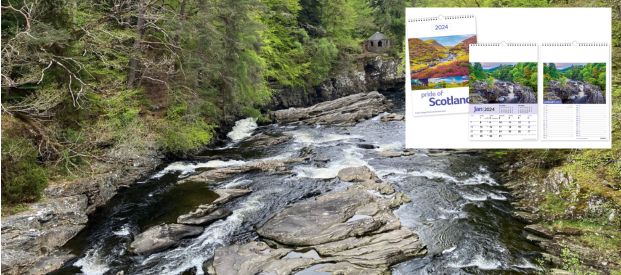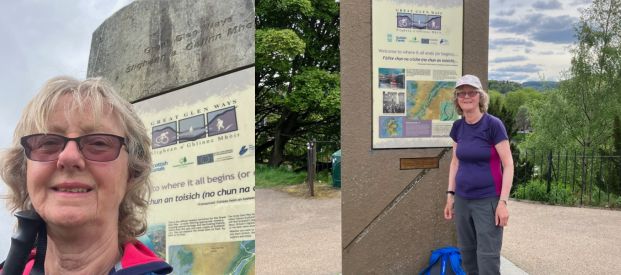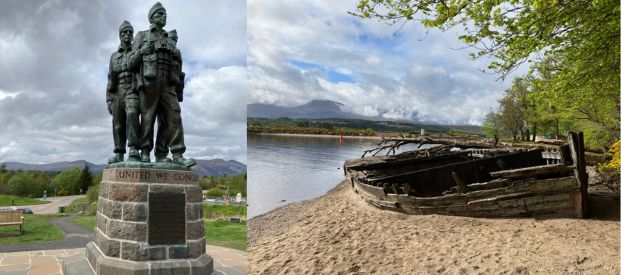Discovering the Great Glen Way
The Great Glen Way is a stunning and varied 77-mile path from Fort William to Inverness. As the name suggests, it follows the Great Glen, the natural geological fault line running across Scotland from southwest to northeast.
The walk begins at Fort William, in the shadow of Ben Nevis, Britain’s highest mountain, starting at the Old Fort on the shores of Loch Linnhe. From there the route heads north along the Caledonian Canal past Neptune’s Staircase, an iconic flight of eight locks, and on to Gairlochy, before continuing along the banks of Loch Lochy, Loch Oich and Loch Ness. Finally leaving Loch Ness, it travels through the Abriachan Forest and plateau to arrive at Inverness, capital of the Highlands, finishing at the Castle.
One of the noteworthy aspects of this route, is that it offers spectacular views, scenery and mountains, many which feature in the pages of our scenic calendars every year.

Pride of Scotland Calendar accompanied by Alison’s picture of Invermoriston Falls
The Great Glen Way is easier than many long-distance walks as it is a predominantly low-level walk along tranquil canal towpaths, enchanting forest tracks and woodland paths and ancient cattle drovers’ routes. It is a very well way marked route with clear guide posts along the way, painted blue and bearing the emblem of a thistle. The paths and trackways are all excellent and well-maintained.
When Rose family member and content contributor Alison Hilton told us she planned to walk the route, we immediately asked her to document her adventure and see if she could spot some of the iconic photo opportunities along the way.

Alison Hilton at the beginning and end of her adventurous walk of the Great Glen Way
Alison decided to walk the Great Glen Way as she had walked the West Highland Way in 2018 which finishes in Fort William, where the Great Glen Way starts, so it was a continuation of this previous walk. Once again, it was a solo walk for Alison, which she actually enjoyed, meaning she could walk at her own pace, and stop wherever she liked, encountering many other friendly walkers along the route.
The majority of the walking was through lush pine forests and ancient woodlands, home to rare native wildlife such as pine martens, red squirrels, Scottish wildcats and golden eagles. Alison frequently heard the sound of cuckoos, recognised a kestrel and a buzzard circling over the treetops and even saw a young roe deer with its white rump hurry away when it heard someone approaching.
Alison walked The Great Glen Way in early May when the hillsides above the lochs and the canal banks were covered with brilliant yellow gorse. Heather along the path was beginning to form its tiny flowers and spruce and fir trees were sprouting their cones. Clusters of primroses, wood anemones and bluebells alongside the path were constant companions for her.
In two sections of the Great Glen Way it divides into a High and Low Route. Each time our intrepid walker took the high route, which provided stunning views of the lochs of the Great Glen and wonderful vistas of distant mountains, some with their summits covered in snow.
Some of the rich history and culture of Scotland is revealed as the route continues past forts and castles such as the ruined Urquhart Castle on the shores of Loch Ness, built around 1250, and Old Inverlochy Castle, dating from 1260. Mysterious abandoned sailing craft and large flat-bottomed wooden boats can be seen resting on some of the small sandy beaches along the loch shores.
The walk passes near the Clan Cameron Museum, covering the history of the clan and its Jacobite connections and photos of when the area around the Great Glen was used for training of around 25,000 commandos during World War 2, centred around Achnacarry House. Nearby, at Spean Bridge the famous 17ft-high Commando memorial can be viewes, a bronze statue of three Commando soldiers looking towards Ben Nevis and the surrounding mountains, with the inscription ‘United We Conquer’.
The Caledonian Canal itself, a marvel of engineering, was designed by Thomas Telford and William Jessop and opened in 1822 to link the west and east coasts of Scotland via the lochs of the Great Glen fault. Highlights along the route are the series of eight locks of Neptune’s Staircase at Banavie and the flight of four locks at Fort Augustus, where sailing boats can be raised up through each lock.
There are many bridges along the route, such as the elegant Bridge of Oich, a double cantilever chain bridge built across the River Oich in 1850. In Invermoriston the splendid double-arched Old Bridge, also built by Thomas Telford in 1813, spans the magnificent Invermoriston Falls, where the River Moriston tumbles across bands of rock over rapids through deciduous and conifer woodland on its way to meet Loch Ness.
Our adventurer thoroughly recommends the Great Glen Way as a long-distance walk, confirming it’s easily achievable by an ‘average’ walker in 6-7 days, with many interesting places to stay overnight, such as Fort Augustus and Drumnadrochit. It could also be done in single sections, as there is a good bus service along much of the route. People often cycle the Great Glen Way and some even canoeing it.
If you enjoy stunning scenery, gentle walking and discovering the UK, why not challenge yourself and embark on an adventure?










